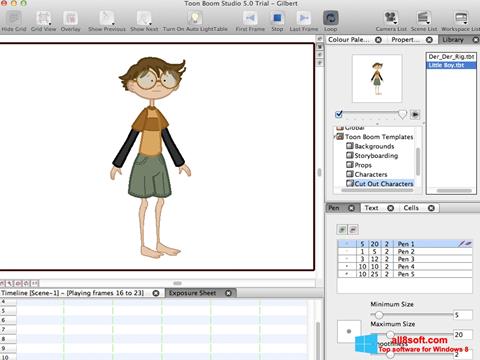
To edit your colour, click the Menu button and select Colour > Edit Colour. Or double-click the colour pot or click the Edit Colour button. Select the colour you want from the colour wheel. Type in the HSV or RGB value in the value fields. Click on the R,G,B,H,S or V radio buttons to change the look of the colour picking area.Ĭlick the Dropper button to select any colour on your screen. It can be from the Toon Boom Studio’s interface, your operating system, or any other opened application. You only need to disable the rough layer to prevent it from appearing in the scene.If needed, click the Shade Scale’s swatches to modify the shade of the selected colour. This method allows you to keep the roughs and the cleans intact.
Toon boom studio 8 getting started full#
Repeat these steps for the rest of your rough drawings until you have a full set of clean ones. In the Drawing or Camera view, trace your next drawing. In the Timeline or Exposure Sheet view, select the next cell corresponding to a rough drawing.
Toon boom studio 8 getting started skin#
In the Onion Skin toolbar, select the Enable Onion Skin button and extend the previous and next drawing numbers. You can do this in two ways, by deselecting these layers in the Timeline to affect what is seen in the Camera view, or by disabling them in the Exposure Sheet view to affect the Drawing view. If you have some other layers in the way, you can deselect them temporarily so that only your rough animation and your clean-up layer are displayed. In the Camera view, start tracing the first key drawing. Pick a bold dark colour, such as black to make sure it contrasts well with the light colour of your rough animation. In the Colour view, select the colour to trace your animation. In the Drawing Tools toolbar, select a drawing tool. In the Timeline or Exposure Sheet view, select the cell on the clean layer corresponding to the first key drawing of your rough animation. This is to prevent any accidental changes. In the Timeline view, select your rough layer,Ĭlick the Menu button, and select Lock > Lock. In the Timeline view toolbar, click the Add Drawing Layer button. To trace your animation in a new layer: 1. Light Table feature in order to display all the layers of your project. If you plan on tracing your animation in the Drawing view, you need to turn on the This is the equivalent of adding a sheet of paper and tracing over the rough using the animation disk. You need to add a new drawing layer to draw your clean drawings. This is the final paperless animation step before the ink and paint step. It consists of tracing solid and clean lines over the rough animation to get closed zones. When your rough animation is ready, it is time to clean it up and ink it. In the Timeline or Exposure Sheet view, select a new cell and repeat these steps for the new drawings. In the Exposure Sheet View, select a cell between your two key drawings.

In the Camera view, draw your second key drawing. In the Timeline or Exposure Sheet view, select the cell where your next key drawing will appear. In the Onion Skin toolbar, click the Enable Onion Skin button.įrom the Onion Skin toolbar, click the onion skin's Previous or Next drawing buttons and from their drop-downs, select the number of previous and next visible drawings that you think you will need.

In the Drawing or Camera view, draw the first key drawing. In the Timeline or Exposure Sheet view, select the cell where the first drawing will appear. It is a good idea to choose a light colour for your rough animation to help for the following task, the clean up process. In the Drawing Tools toolbar, select the Brush tool or press the Colour view, select the colour you will use to draw. In the Timeline view, create a new drawing layer and name it Rough.

If you start animating the details right away, you lose a lot of time if you have to do corrections, and your animation often looks too rigid. The head, arms, and clothes are added later, during the secondary animation.įor a satisfactory animation, complete the main action before adding all the details. For example, to animate a walk-cycle, you will start with the torso moves and the legs. You would usually start with the main action.

The first step to complete is the rough animation, which is the skeleton of your animation.


 0 kommentar(er)
0 kommentar(er)
